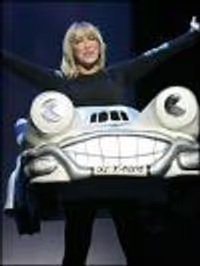Are new cast recordings "The aural equivalent of an airbrushed photograph,"
Dave19
Broadway Legend Joined: 12/23/11
#25Are new cast recordings
Posted: 4/14/13 at 7:24amYour comment is tragic. A cast recording is the only thing that will stay forever.
#26Are new cast recordings
Posted: 4/14/13 at 7:40am
For certain shows I wish they would have recorded live rather than in the studio. Sometimes there is an extra bit of magic in a live recording; even the greatest singers can't replicate when studio-bound.
For example (from the opera world, but still): Compare Sutherland's studio recording of La Fille du Regiment with Sills' live recording. Sutherland is in excellent voice, and often puts on a dazzling coloratura workshop. Nothing can compare to the excitement of the live Sills recording though. Sure there are stage sounds, audience coughs/applause and momentary severe imbalances with the orchestra, but that performance!! The Lesson is so genius that it's hard to argue it's ever been recorded in better fashion.
I doubt Sills couldn't have replicated that performance in the studio.
I'm not advocating for all shows to have a live recording, but I don't think it's a major hindrance when done correctly.
#27Are new cast recordings
Posted: 4/14/13 at 12:57pm
Perhaps the lousy sound on many of the current OCRs has something to do with "the loudness war"? The link at the bottom goes to an excellent video providing a simple explanation with a before and after audio example and makes it easier to understand.
With the advent of the Compact Disc (CD), music is encoded to a digital format with a clearly defined maximum peak amplitude. Once the maximum amplitude of a CD is reached, loudness can be increased still further through signal processing techniques such as dynamic range compression and equalization. Engineers can apply an increasingly high ratio of compression to a recording until it more frequently peaks at the maximum amplitude. In extreme cases, clipping and other audible distortion is introduced to increase loudness further. Modern recordings that use extreme dynamic range compression and other measures to increase loudness therefore sacrifice sound quality to loudness. The competitive escalation of loudness has led music fans and members of the musical press to refer to the affected albums as "victims of the loudness war".
The Loudness War example
#28Are new cast recordings
Posted: 4/14/13 at 1:55pm
I've unloaded lots on this topic before and have found I only confuse people with all the jargon, so I will give an example of a cast recording I adore for its engineering and overall sound, then a brief (OK, OK, not so brief) explanation will follow.
Showboat - 1993 Canadian Revival
Yes, the sound is up close and personal but the singers have room to breathe and it doesn't sound dry (no reverb at all) or too wet (copious amounts of echoey reverb). It also doesn't attempt to mimic the sound of a live theatre performance, which almost always sounds as if it is being performed in a cave. I have issues with the speed racer tempo on this recording, but the fact they make the orchestra just as relevant as the singer makes up for all of that. I especially dig the detail you can hear in the instrumentation; that scratchy string quality and that hollow, deep clarinet presence just to name two. It's perfect.
I guess it all comes down to what the listener wants to experience and appreciate. If they want to relive a performance from their own audience perspective, they will want that quality recreated on disc. If you're all about nuances that nobody notices or cares about, that color and add texture and expression to a musical piece, then up close and personal is the way to go.
However, I agree about today's lackluster cast album quality. Morosco has mentioned one of the main culprits for the crappy sound these days; they want to shove everything into your ear at once without regard to balance because somebody equated loudness with clarity, and why anyone followed, beats me.
Another reason cast albums suck these days is orchestras and human musicians are being replaced by machines and sample-based, virtual orchestras that don't come even close to creating the sound that only a human and an authentic instrument can. In a disgusting new trend, however, many shows' classic and beloved orchestrations are being "updated." Not so, they are being stripped and the parts moved around to create the illusion of newness, when what is really happening is reduction and thinning-out. One of the more popular methods is to chuck the typically 6-10 member original string section and its harmonies, replacing it with a loud ass single cello or viola, giving the impression there is added texture and presence. In reality, it's a dumbing down of the formerly rich, harmonious blend of different string textures, which people are mostly ignorant about and assume are whipped out of the composer's ass like nothing and somehow just dumped on a disc. So when they hear that loud ass cello in place of what confused and made them scratch their heads, they accept it as an improvement because they can identify it as a loud ass cello. To those of us who noticed that moving harmony and distinct blend, it is a travesty and a sad sign of the times.
Videos




